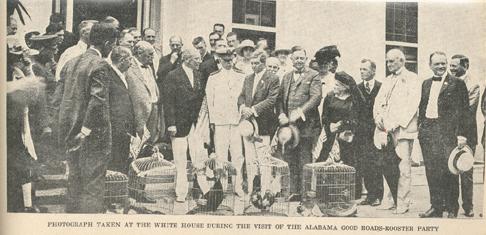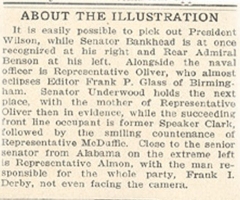Innovative Financing Tip for Communities at Their Wit's End
In good times and bad, the Rambler can safely say State and local governments never have enough money for their highway needs. It has always been so. In recent years, the Federal Highway Administration has spearheaded "innovative financing" techniques that can help meet needs. There's even a website about it: https://www.fhwa.dot.gov/ipd/finance/
However, innovative solutions are nothing new. For example, Senator John H. Bankhead, who represented Alabama in the United States Senate from 1907 until his death in 1919, was known as the Father of Federal-Aid because of his advocacy for the Federal-Aid Road Act of 1916. While seeing the value of Federal funding for road building, he explored other options, too. AAA's American Motorist magazine for September 1919 contained a short article ("Who Crows Here?") about one such example:
As the result of a sale of some 5,000 roosters on August 15, a bridge is to be built across the Tombigbee river at Demopolis, Alabama. Thus another obstacle on the Dixie Overland highway is to be removed. The bridge is to cost about $175,000. The rooster sale netted about $250,000 [approximately $50 each]. The additional funds will be utilized to improve the road and the approaches to the bridge in Marengo and Sumter counties. The work will be carried on under the direction of the State Highway Department of Alabama.
Four of these birds were donated by President Wilson, Lloyd George of England, and Premiers Clemenceau of France and Orlando of Italy. The idea of the rooster sale came from F. L. Derby, a stockman of Alabama. He was the originator of the bull sale last year at the same place which netted the Red Cross $208,000.
An accompanying photo shows "the Alabama Good Roads-Rooster Party" during a visit with President Wilson at the White House. The caption notes that President Wilson can be easily picked out, but for those who may not be able to pick him out easily, he's standing on Rear Admiral Benson's right. The caption adds that Senator Bankhead "is at once recognized at his right," referring of course to the President's right. Almost all other participants are identified (including Mr. Derby), but the caption makes no reference to the four roosters caged in front of the assembled crowd. They are, indeed, the illustrious roosters donated by their famous owners to the cause of Good Roads.


The "Rooster Bridge," as it was known, served traffic on the Dixie Overland Highway and U.S. 80 until 1980, when it was demolished and replaced by a bridge on new location. A second parallel bridge will soon be built at the new location.
UPDATED: Alas! Before embarking on a rooster auction to fund your latest mega-project, you may want to read Becky Willis' article, "Rooster Bridge," in the Winter 2003 issue of Alabama Heritage magazine. She reported that the auction took place on August 4-5, 1919, and resulted in bids and pledges totaling between $200,000 and $300,000. The top bird was, as might be expected, was President Wilson's rooster (nicknamed "Woodrow"), which sold for $55,000. Ms. Willis adds:
These figures, however, were on paper only. An article in The Demopolis Times stated, "In all the excitement, proper records of some of the purchasers and their bids were not made and a great deal of money was never paid.
Even the bidder who won "Woodrow" neglected to pay for his rooster. In all, the effort raised only $45,000 for the bridge. As a result, construction was delayed until 1922.
(Ms. Willis does not speculate on the motivation of those who failed to pay their pledged amounts. The Rambler suspects-and it can by only a suspicion-that they came to their senses and thought, "How am I going to tell my wife I just paid $55,000 for a rooster?")
The new bridge opened on May 15, 1925, and was officially designated the Memorial Bridge in honor of World War I veterans. Locals, however, called it the Rooster Bridge, a name that became official when Governor John Patterson signed Legislative Act 99 on June 24, 1959. Ms. Willis concludes her article with the following:
A 1971 resolution passed by the Alabama Legislature decreed that any bridge or bridges that cross the Tombigbee River at that point shall bear the name Rooster Bridge.

